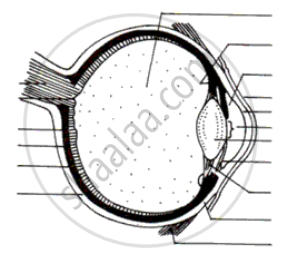Advertisements
Advertisements
प्रश्न
Given below is a set of five parts. Rewrite them in correct sequence.
Conjunctiva, retina, cornea, optic nerve, lens.
उत्तर
Conjunctiva → cornea → lens → retina → optic nerve.
APPEARS IN
संबंधित प्रश्न
The region of the vertebrate eye, where the optic nerve passes out of the retina, is called the
(a) fovea
(b) iris
(c) blind spot
(d) optic chaisma
Describe the anatomy of the human eye.
The optical prescription for a pair of spectacles is :
Right eye : −3.50 D
Left eye : −4.00 D
Which lens has a greater focal length?
Name the part of the eye:
on which the image is formed.
What is the name of:
the curved, transparent front surface of the eye?
What is the name of:
the light-sensitive layer in the eye?
What is the range of vision of a normal human eye?
What changes take place in the shape of eye-lens:
when the eye is focused on a near object?
Nocturnal animals (animals which sleep during the day and come out at night) tend to have wide pupils and lot of rods in their retinas. Suggest reasons for this.
Among animals, the predators (like lions) have their eyes facing forward at the front of their heads, whereas the animals of prey (like rabbit) usually have eyes at the sides of their head. Why is this so?
With both eyes open, a person's field of view is about:
(a) 90°
(b) 150°
(c) 180°
(d) 360°
The figure below compares a part of our eye with a part of a photographic camera.

Name the corresponding parts of the eye the camera shown here that are comparable in function.
Label the following diagram :

Name the following:
The pigmented circular area seen in the eye.
Mention, if the following statement is True or False
Cones are the receptor cells in the retina of the eye sensitive to dim light.
Mention, if the following statement is True or False
Rods are responsible for vision in the dark
State the Function:
Choroid coat in the eye
A small hole of changing diameter at the centre of Iris is called _______.
Name the capacity of the eye lens to change its focal length as per need.
The black opening between the aqueous humour and the lens is called ____________.
